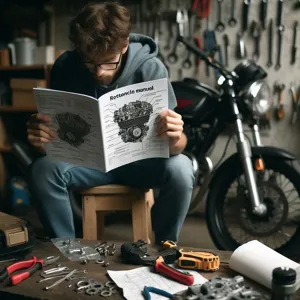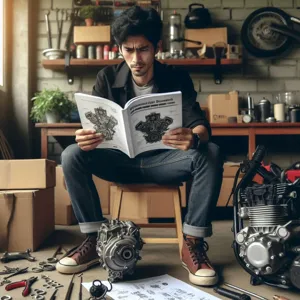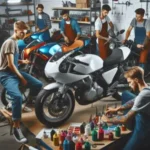For many, the thrill of riding a motorbike is matched only by the intrigue of understanding what makes it roar to life.
But for beginners, navigating the world of motorbike engine specifications can feel like deciphering a foreign language. From horsepower to torque, displacement to compression ratios, these technical terms hold the key to unlocking the true performance and power of your ride. Whether you’re a novice looking to buy your first bike or an enthusiast eager to enhance your knowledge, this beginner’s guide will break down the essential elements of motorbike engines, demystifying the specifications that dictate how your machine performs on the road. Join us as we dive into the mechanics of motorbike engines, equipping you with the knowledge to make informed decisions and truly appreciate the engineering marvel behind every ride.
1. Introduction to Motorbike Engine Specifications

When it comes to motorbikes, the engine is the heart that powers the ride, and understanding its specifications is crucial for anyone looking to navigate the world of two-wheeled machines. Whether you’re a novice rider contemplating your first purchase or an experienced enthusiast aiming to upgrade, familiarizing yourself with engine specifications can significantly enhance your riding experience. This guide is designed to demystify the technical jargon and break down the essential components that contribute to a motorbike’s performance and power.
Motorbike engines come in various configurations, sizes, and technologies, each influencing how a bike behaves on the road. Key specifications include engine displacement, which refers to the total volume of all the cylinders in the engine, typically measured in cubic centimeters (cc). This figure is often a primary indicator of the engine’s power output and potential speed. Additionally, horsepower and torque are pivotal metrics that describe the engine’s ability to perform under different conditions, with horsepower representing the engine’s top speed capabilities and torque reflecting its acceleration and pulling power.
Understanding the difference between air-cooled and liquid-cooled engines, the significance of fuel types (such as unleaded or high-octane), and the implications of various engine layouts (like parallel twin, V-twin, or inline-four) can also help you make informed decisions when considering a motorbike. With this introduction, you’ll be better equipped to interpret the specifications that matter most, allowing you to choose a motorbike that aligns perfectly with your riding style and performance expectations. Buckle up as we dive deeper into the fascinating world of motorbike engine specifications!
2. Understanding Engine Displacement: What It Means
Engine displacement is one of the most fundamental specifications to grasp when delving into the world of motorbike performance. Simply put, displacement refers to the total volume of all the cylinders in an engine, measured in cubic centimeters (cc) or liters. This measurement essentially indicates the engine’s capacity to draw in air and fuel, which directly correlates to its power output.
To visualize this, think of engine displacement as the size of a balloon. A larger balloon can hold more air, just as a larger engine can accommodate more air-fuel mixture. Therefore, a motorcycle with a higher displacement typically boasts greater horsepower and torque, allowing it to accelerate faster and achieve higher speeds. For example, a 1000cc engine is generally more powerful than a 500cc engine, making it better suited for high-performance riding scenarios.
However, it’s important to note that displacement alone doesn’t paint the complete picture of an engine’s capabilities. Factors such as engine design, the number of cylinders, fuel delivery systems, and tuning also play crucial roles in determining overall performance. A smaller engine with advanced technology and efficient tuning can sometimes outperform a larger engine that lacks these characteristics.
For beginners, understanding engine displacement is essential as it helps in making informed decisions when purchasing a motorcycle. If you’re looking for a bike for leisurely rides, a model with smaller displacement may suffice. However, if thrilling speed and power are what you seek, aiming for a bike with a larger engine can significantly enhance your riding experience. As you dive deeper into the specifications, you’ll discover that engine displacement is just the first step in unlocking the intricacies of motorbike performance and power.
3. The Role of Horsepower in Motorcycle Performance

Horsepower is often touted as the benchmark for a motorcycle’s performance, acting as a pivotal metric that enthusiasts and beginners alike reference when evaluating a bike’s capabilities. But what exactly does horsepower mean, and why is it so crucial in the context of motorcycle performance?
At its core, horsepower is a unit of measurement that quantifies the power output of an engine. It reflects how quickly the engine can do work — in this case, propelling the motorcycle forward. The higher the horsepower rating, the more power the engine can produce. This translates to greater acceleration, higher top speeds, and an overall more exhilarating riding experience. However, it’s essential to understand that horsepower alone doesn’t tell the whole story.
When we delve deeper, we find that horsepower is closely linked to torque, the twisting force that the engine generates. While horsepower measures how fast an engine can work, torque determines how much pulling power it has, especially at lower RPMs. A well-balanced combination of both horsepower and torque can significantly impact how a motorcycle performs in various riding conditions, whether it’s a leisurely cruise through city streets or a high-speed dash on the open highway.
For beginners, understanding horsepower can guide you in choosing the right motorcycle for your riding style. If you’re looking for a bike that offers quick acceleration and thrilling rides, a model with a higher horsepower rating may be more suitable. Conversely, if you prefer a bike that’s easier to handle, especially for city commuting or beginner-level riding, you might want to look for one that balances moderate horsepower with good torque.
In summary, horsepower is a critical element in the performance equation of a motorcycle. It’s not merely a number on a spec sheet—it’s an indication of the bike’s potential to deliver the thrilling rides that motorcyclists crave. As you explore different models, keep in mind that a thorough understanding of horsepower will help you decode the performance capabilities of each motorcycle you encounter, ensuring you make an informed choice that aligns with your riding aspirations.
4. Torque Explained: Why It Matters for Acceleration
When diving into the world of motorbike engine specifications, understanding torque is essential, especially when it comes to acceleration. Torque, measured in pound-feet (lb-ft) or Newton-meters (Nm), represents the twisting force produced by the engine. Think of it as the engine’s ability to do work; the higher the torque, the more force available to propel the bike forward from a standstill.
For beginners, grasping the significance of torque can be likened to understanding how a bicycle operates. Imagine pedaling uphill: the effort you exert is akin to torque. The more torque your motorbike generates, the easier it is to accelerate, especially from lower revs. This is particularly crucial in situations such as merging onto highways or navigating city traffic, where quick bursts of power are necessary.
A bike with a high torque rating provides a thrilling, responsive ride, allowing it to accelerate rapidly without the need to rev the engine to high RPMs. This characteristic is especially advantageous for cruisers and touring bikes, where low-end torque contributes to a smooth and enjoyable riding experience. Conversely, sportbikes may prioritize higher RPM power for top-speed performance, but a solid torque curve can enhance everyday usability and responsiveness.
Understanding torque also informs how you choose to ride. Bikes with ample low-end torque can be more approachable for beginners, offering the confidence to handle various riding scenarios without constantly wrestling with the throttle. In essence, torque is more than just a number on a spec sheet; it’s a vital component that directly affects your riding experience, making it crucial for anyone looking to decode motorbike specifications and unlock the full potential of their machine.
5. The Importance of RPM: What to Look For

When delving into the world of motorbike engine specifications, understanding RPM (revolutions per minute) is crucial for evaluating a bike’s performance and power potential. RPM measures how many times the engine’s crankshaft completes a full rotation each minute, and this figure is key to grasping how an engine operates under various conditions.
To assess the significance of RPM, first consider the relationship between engine speed and power output. Most motorcycle engines produce their maximum power at a certain RPM range, often referred to as the “power band.” This is where the engine feels most responsive, delivering exhilarating acceleration and speed. For beginners, knowing this range is essential: it tells you when to shift gears to maintain optimal performance without straining the engine.
Moreover, RPM affects torque, the twisting force that propels the bike forward. Generally, a higher RPM can mean increased power, but it also means that the engine is working harder, which can impact fuel efficiency. As a beginner, it’s important to strike a balance between performance and practicality. Look for bikes with a good torque curve that provides ample power at lower RPMs for urban riding, while still offering the thrill of higher RPMs for those open-road excursions.
Additionally, pay attention to the redline—the maximum RPM the engine can handle before potential damage occurs. Understanding where this threshold lies can help you avoid over-revving and ensure a longer engine lifespan.
Ultimately, as you decode motorbike engine specifications, remembering the importance of RPM will empower you to choose a bike that aligns with your riding style, whether you’re cruising through city streets or tearing down the highway. By keeping RPM in mind, you’ll be better equipped to appreciate the nuances of engine performance and make informed decisions that enhance your riding experience.
6. Fuel Types and Their Impact on Engine Performance
When it comes to motorbike engines, the type of fuel you choose can dramatically influence performance, efficiency, and overall riding experience. Understanding the differences between fuel types is essential for any budding motorbike enthusiast.
Most motorcycles operate on either regular unleaded gasoline, premium gasoline, or a blend of both. Regular unleaded fuel, typically rated at 87 octane, is the standard choice for many entry-level bikes and commuter models. However, while it may be economical, using lower octane fuel in high-performance engines designed for premium fuel can lead to knocking or pinging—unwanted sounds that indicate engine stress.
Premium gasoline, with an octane rating of 91 or higher, is specially formulated to withstand the higher compression ratios prevalent in performance-oriented bikes. This fuel type not only enhances power output but also promotes smoother acceleration and improved throttle response. For riders who crave speed and agility, opting for premium fuel can mean the difference between a thrilling ride and a sluggish performance.
In addition to octane ratings, the fuel’s formulation also plays a crucial role in engine performance. The introduction of ethanol in fuel blends, for instance, has become common practice in many regions. While ethanol can provide some environmental benefits, it can also affect performance. Ethanol-blended fuels may absorb moisture and lead to corrosion in older engines, potentially causing damage over time. Furthermore, these fuels often yield less energy than traditional gasoline, which can impact your bike’s efficiency and power delivery.
For those who ride vintage or classic motorcycles, it’s vital to choose fuels that align with the engine’s specifications to avoid any adverse effects. Specialty fuels are available that cater specifically to older engines, ensuring optimal performance without compromising integrity.
In summary, understanding the impact of fuel types on motorbike engine performance is not just about picking the most expensive option. It’s about aligning your fuel choice with your bike’s design, purpose, and your riding style. As you decode the intricacies of engine specifications, remember that the right fuel can unlock the full potential of your motorcycle, enhancing every ride.
7. Compression Ratio: Understanding Its Significance

The compression ratio is a fundamental aspect of any motorbike engine that significantly impacts its performance, efficiency, and power output. At its core, the compression ratio is a simple numerical representation of the relationship between the volume of the combustion chamber when the piston is at the bottom of its stroke (BDC) and the volume when the piston is at the top of its stroke (TDC). It is expressed as a ratio, such as 10:1, which means that the volume of the chamber at BDC is ten times greater than at TDC.
So why is this ratio so crucial? A higher compression ratio typically indicates that the engine can generate more power from the same amount of fuel. This is because a greater compression allows for a more efficient combustion process, leading to a more powerful explosion within the cylinder when the fuel-air mixture ignites. Consequently, engines with higher compression ratios often produce more horsepower and torque, enabling better acceleration and overall performance.
However, it’s essential to balance the compression ratio with considerations like fuel quality and engine design. Higher compression can lead to knocking or pinging, which occurs when the fuel-air mixture ignites prematurely due to excessive pressure. This phenomenon can damage the engine over time, so it’s crucial to use high-octane fuel that can withstand the increased pressure without causing detonation.
For beginners, understanding the implications of compression ratios can guide not only the choice of the motorbike but also how to maintain and modify it for optimal performance. When shopping for a bike, be mindful of its compression ratio in relation to your riding style and the type of fuel you plan to use. A motorbike with a compression ratio that matches your needs can lead to an exhilarating ride while ensuring the longevity of your engine. In essence, the compression ratio is a key player in the game of performance and power, making it a vital specification to decode as you dive into the world of motorbikes.
8. Cooling Systems: Air-Cooled vs. Liquid-Cooled Engines
When it comes to understanding motorbike engine specifications, one of the crucial elements to consider is the cooling system. A well-functioning cooling system ensures that your engine operates efficiently, maintaining optimal performance while preventing overheating. The two primary types of cooling systems found in motorbike engines are air-cooled and liquid-cooled systems, each with its distinct advantages and characteristics.
**Air-Cooled Engines**
Air-cooled engines utilize the natural flow of air to dissipate heat. As the engine runs, fins attached to the engine block increase the surface area, allowing more air to pass over the engine and carry away excess heat. This system is simpler in design, often lighter, and requires less maintenance, making it a popular choice for smaller bikes and vintage models. However, it can struggle in extreme conditions, such as stop-and-go traffic or hot weather, where airflow is minimal. Riders may notice that air-cooled engines can run hotter under these conditions, potentially affecting performance.
**Liquid-Cooled Engines**
On the other hand, liquid-cooled engines employ a more sophisticated system that circulates coolant through the engine block, absorbing heat and transferring it to a radiator, where it is cooled by airflow. This type of cooling system is more efficient, allowing for better temperature regulation and improved performance, especially in high-performance bikes or larger engines. Liquid-cooling is particularly advantageous for riders who frequently tackle long rides or challenging terrains, as it minimizes the risk of overheating. However, this system is typically heavier and more complex, requiring regular maintenance checks for leaks and coolant levels.
Ultimately, the choice between air-cooled and liquid-cooled engines comes down to the rider’s needs and the intended use of the motorcycle. Understanding these cooling systems is essential for beginners looking to decode the intricacies of motorbike performance and power. Whether you prioritize simplicity and lower maintenance or seek the reliability of advanced cooling technology, being informed about these specifications will help you make a more educated decision when selecting your next ride.
9. The Impact of Engine Configuration: Inline, V-Twin, and More
When diving into the world of motorbike engines, one of the most significant factors that influence a bike’s performance and power is its engine configuration. Understanding these configurations—primarily inline and V-twin—can dramatically enhance your knowledge of how bikes operate and how to choose the right one for your riding style.
**Inline Engines**
Inline engines, commonly found in sportbikes and touring motorcycles, feature cylinders arranged in a straight line, typically either four or three cylinders. This configuration allows for a smoother operation and higher RPMs, translating to impressive power outputs. Because of the balanced nature of inline engines, they tend to have less vibration, making long rides more comfortable. The design also allows for a more compact engine, which contributes to a leaner bike profile. Riders often appreciate the quick throttle response and the high-revving capabilities of these engines, making them ideal for those who enjoy spirited riding and agility on twisting roads.
**V-Twin Engines**
On the other hand, V-twin engines are a hallmark of cruiser and touring bikes, with their cylinders arranged in a “V” shape. This configuration, often with two cylinders, produces a distinctive rumble and a strong low-end torque, making them ideal for laid-back cruising and acceleration from low speeds. The V-twin’s torque delivery is particularly favorable for riders who prefer a more relaxed riding experience, as it provides ample power without the need for constant shifting. However, the V-twin’s design can lead to more vibration at high speeds, which is something to consider if you plan on long-distance rides.
**Other Configurations**
While inline and V-twin engines dominate the motorcycle landscape, other configurations exist, such as parallel twins, flat engines, and even triples. Each has its unique characteristics, advantages, and disadvantages, contributing to different riding experiences. For instance, parallel twins often offer a balance between the compactness of inline engines and the torque of V-twins, making them versatile for various types of riders.
Ultimately, the engine configuration you choose will have a profound impact on your riding style and experience. Whether you lean towards the high-revving nature of inline engines or the torque-rich power of V-twins, understanding these differences is essential for decoding motorbike engine specifications and selecting the motorcycle that best suits your aspirations on the open road.
10. Understanding Engine Technology: Carburetors vs. Fuel Injection
When it comes to motorbike engines, one of the most crucial distinctions to understand is the difference between carburetors and fuel injection systems. These two technologies play a pivotal role in how your bike performs, and knowing their advantages and disadvantages can significantly influence your riding experience.
**Carburetors** are traditional devices that mix air and fuel in a specific ratio before sending it into the engine. They operate on the principle of vacuum, leveraging the natural airflow created by the engine to pull in fuel. Riders who appreciate the vintage charm of older bikes often favor carburetors for their simplicity and ease of maintenance. Tuning a carbureted engine can be a rewarding experience, allowing enthusiasts to fine-tune performance based on individual preferences. However, carburetors can sometimes struggle with fuel efficiency and emissions, particularly in varying conditions, as they lack the adaptability of modern systems.
On the other hand, **fuel injection (FI)** has become the standard for most contemporary motorbikes. This technology utilizes electronic sensors to monitor various engine parameters, such as air intake and temperature, and adjust the fuel delivery accordingly. As a result, fuel-injected engines tend to deliver better fuel efficiency, smoother acceleration, and reduced emissions. This adaptive response makes them ideal for a wide range of riding conditions, from city commutes to high-speed highway cruising. However, the complexity of fuel injection systems can make them more challenging and expensive to repair if issues arise.
Ultimately, the choice between carburetors and fuel injection comes down to personal preference and riding style. Carburetors may appeal to those who enjoy the tactile experience of tuning their bike, while fuel injection offers the reliability and efficiency that modern riders often seek. Understanding these engine technologies not only helps you make an informed decision when purchasing a bike but also enriches your overall riding experience by deepening your appreciation for the mechanics that power your passion.
11. The Role of Exhaust Systems in Performance
When it comes to motorbike performance, the exhaust system plays a pivotal role that often goes underestimated by beginners. Think of the exhaust as the lungs of your bike; it not only expels the spent gases from the engine but also significantly influences how efficiently that engine can breathe. A well-designed exhaust system can enhance power output, improve fuel efficiency, and even alter the sound of your bike, giving it that exhilarating roar that many riders crave.
At its core, the exhaust system comprises several components, including headers, mufflers, and catalytic converters, each serving a specific function. Headers channel exhaust gases away from the engine, while mufflers dampen sound and reduce noise pollution. Aftermarket options often modify these components to optimize performance. For instance, a performance header can reduce back pressure, allowing for a quicker exit of exhaust gases and thereby increasing horsepower. Meanwhile, a less restrictive muffler can enhance sound without sacrificing power, appealing to both performance enthusiasts and those who appreciate a good growl on the open road.
Moreover, the material of the exhaust system can impact weight and durability. Stainless steel and titanium are popular choices for performance exhausts due to their strength and resistance to corrosion. A lighter exhaust can reduce the overall weight of the bike, leading to better handling and acceleration, which is a significant advantage for competitive riders.
In summary, the exhaust system is more than just a shiny addition to your motorbike; it’s an integral part of your bike’s performance profile. Whether you’re looking to enhance speed, improve fuel efficiency, or simply enjoy a more aggressive sound, understanding how exhaust systems work is key to decoding motorbike engine specifications and making informed decisions about upgrades. So, next time you rev your bike, remember that the exhaust doesn’t just let the engine breathe; it helps your bike roar to life.
12. How Weight and Power-to-Weight Ratio Affect Handling
When it comes to motorcycle performance, understanding how weight and power-to-weight ratio play a crucial role in handling is essential for any budding rider. The weight of a bike is not just a number; it influences every aspect of how the motorcycle responds to your inputs, affects acceleration, braking, and cornering capabilities, and ultimately determines the overall riding experience.
The power-to-weight ratio is a key metric that compares the engine’s power output to the bike’s weight. A high power-to-weight ratio means that the motorcycle has more power available for each kilogram it carries, leading to snappier acceleration and more agile handling. For instance, a lightweight sportbike with a powerful engine can dart through corners with ease, providing a thrilling and responsive ride. In contrast, a heavier cruiser might boast a larger engine but may feel sluggish in comparison due to its increased mass.
This balance of weight and power becomes particularly evident during turns. A lighter bike can change direction more readily, allowing for quicker lean angles and more confidence in navigating winding roads. Riders often report that lightweight motorcycles feel more “flickable,” giving them the ability to maneuver through tight corners more easily. Conversely, a heavier bike might require more effort to shift its mass, demanding greater skill and experience from the rider.
Moreover, the power-to-weight ratio is not static; it can be affected by various factors such as rider weight, luggage, or modifications made to the bike. For example, adding aftermarket accessories can increase the weight, potentially diminishing the bike’s agility. Hence, it’s vital to consider how you will use your motorcycle and what riding style suits you best.
In summary, both weight and power-to-weight ratio are paramount in determining how a motorcycle handles on the road. As you explore different bikes, pay attention to these specifications—they’re not just numbers; they’re the keys to unlocking the full potential of your riding experience. Understanding this relationship will empower you to make informed decisions, whether you’re choosing your first bike or upgrading to a more performance-oriented model.
13. Evaluating Engine Reliability and Maintenance Needs
When it comes to motorbike engines, reliability and maintenance needs are crucial factors that can significantly impact your riding experience. As a beginner, understanding how these elements interplay can save you time, money, and frustration down the line.
First and foremost, engine reliability is often reflected in its design and build quality. Look for engines known for their durability, particularly those with a reputation for withstanding the rigors of everyday use. Brands that have a longstanding presence in the market typically have honed their engineering to produce reliable machines. Researching customer reviews and industry reports can provide valuable insights into the reliability of specific models.
Maintenance needs are equally important to consider. Every engine requires regular upkeep, but the frequency and complexity can vary widely. Some engines may need simple oil changes and filter replacements every few thousand miles, while others may require more intricate servicing. Checking the manufacturer’s specifications for maintenance schedules will give you an idea of what to expect.
Additionally, consider the availability of parts and service. Opting for a model with widely available parts can ease the burden of repairs and routine maintenance. If you find yourself needing to source rare components or specialized services, it could lead to frustration and increased costs.
Finally, don’t overlook the importance of your own skill level and willingness to perform maintenance. Some riders enjoy getting hands-on with their bikes, while others prefer to leave it to the professionals. Understanding your capabilities will help you choose an engine that aligns with your comfort zone.
Ultimately, a reliable engine that fits your maintenance preferences will not only enhance your riding experience but also ensure you can enjoy your motorbike for years to come. By taking the time to evaluate these factors, you’re setting yourself up for a more fulfilling and hassle-free journey on the open road.
14. Real-World Testing: How to Assess Performance
When it comes to understanding motorbike engine specifications, nothing quite compares to real-world testing. While numbers and graphs from manufacturer data can provide a preliminary understanding of performance, experiencing a bike on the road offers invaluable insights that raw statistics simply cannot convey.
To assess a motorbike’s performance effectively, it’s essential to consider a combination of factors that encompass both the engine’s specifications and the overall riding experience. Start by evaluating how the bike accelerates from a standstill. Pay attention to throttle response and whether the power delivery feels smooth or abrupt. A bike with a well-tuned engine should respond eagerly without unnecessary lag, making for a more exhilarating ride.
Next, consider the bike’s handling and agility. Take it around corners and observe how it responds to your inputs. A bike that feels nimble and planted inspires confidence, while one that struggles with sharp turns may indicate a lack of balance or weight distribution issues. Additionally, assess its braking performance. Effective braking is crucial, so take note of how the bike decelerates under various conditions—whether it’s a gradual slow down or an emergency stop.
Don’t forget to evaluate comfort and ergonomics during your test ride. A bike’s design should allow for a natural riding posture that doesn’t strain your back or wrists, especially on longer journeys. The vibration levels at different speeds can also impact comfort; a smooth ride often translates to a more enjoyable experience.
Finally, consider the sound of the engine. An engine that purrs like a kitten or roars like a lion can enhance the emotional connection between rider and machine. A bike’s exhaust note can be just as significant as its performance figures, adding an element of excitement to the ride.
Ultimately, real-world testing is about immersing yourself in the experience. By combining your observations on acceleration, handling, braking, comfort, and sound, you can better understand how a motorbike’s engine specifications translate into performance on the road. So, gear up, hit the pavement, and enjoy the journey of discovering your perfect ride!
15. Conclusion: Putting It All Together for Smart Buying Decisions
As we reach the conclusion of our journey through the intricate world of motorbike engine specifications, it’s essential to synthesize what we’ve learned into actionable insights that can inform your purchasing decisions. Understanding the nuances of engine size, horsepower, torque, and other key specifications is not just about numbers; it’s about translating these figures into real-world performance and riding experiences.
A well-rounded comprehension of engine specifications empowers you to align your choices with your riding style and preferences. Whether you’re a novice looking for a bike that balances power and ease of handling or a seasoned rider seeking the thrill of high-performance engines, the information gathered here serves as a solid foundation. Remember, it’s not solely about the raw power a motorbike can deliver; it’s also about how that power translates into comfort, control, and safety on the road.
Before making your final decision, take the time to consider the type of riding you plan to do. Are you looking for a commuter bike for city streets, a touring model for long distances, or a sportbike for those weekend thrill rides? Each category has its own set of specifications that cater to different needs.
Additionally, don’t overlook the importance of conducting real-world tests, if possible. Sitting on the bike, feeling its weight, and experiencing how it responds to your commands can provide invaluable insight beyond the specifications on paper. Use your newfound knowledge to assess not only the numbers but also the overall fit and feel of the motorcycle.
In the end, smart buying decisions stem from a combination of understanding engine specifications, aligning them with your personal preferences, and engaging with the motorcycle community for advice and shared experiences. Equip yourself with the right information, and you’ll not only choose a motorbike that suits your needs but also one that enhances your riding journey for years to come. Happy riding!
As we conclude our exploration of motorbike engine specifications, we hope this beginner’s guide has illuminated the intricate world of performance and power for you. Understanding these specifications is crucial for both novice riders and seasoned enthusiasts alike, empowering you to make informed decisions about your bike and its capabilities. From grasping the significance of horsepower and torque to deciphering engine displacement and compression ratios, each detail plays a pivotal role in how your motorbike performs on the road. With this knowledge in hand, you can confidently engage in discussions, choose the right bike for your needs, and even optimize your riding experience. So, gear up, embrace the thrill of the ride, and remember that the more you learn about your machine, the more enjoyable your journey will be. Safe travels and happy riding!






